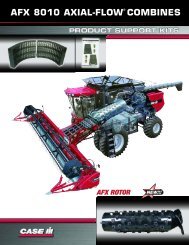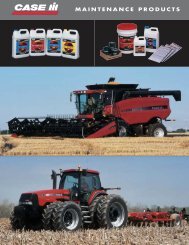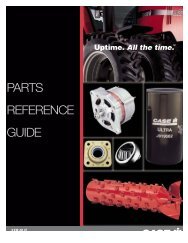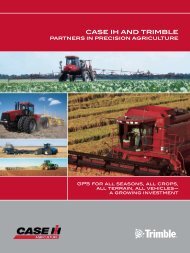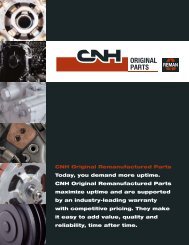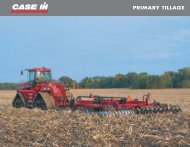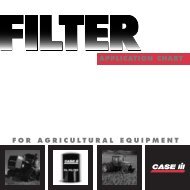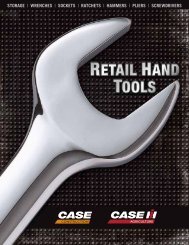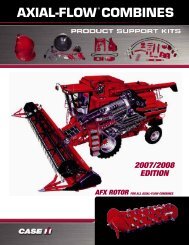Linkage Hardware - Service Motor Company
Linkage Hardware - Service Motor Company
Linkage Hardware - Service Motor Company
Create successful ePaper yourself
Turn your PDF publications into a flip-book with our unique Google optimized e-Paper software.
THE THREE POINT HITCHTOP LINK CONNECTIONOne end of the top link is fastened to the tractor at abracket located behind the tractor's seat. The otherend of the top link is connected to the top bracket ofthe implement ‘A’ frame. Both connections are securedwith a top link pin (similar to a clevis pin).Top link pins are always unthreaded and are held inplace by either a linch pin, or in some cases, a largehairpin clip. (see figure 3) Top links and top link pinsvary in length, but their respective ball socket holesand pin diameters are standardized by horsepowercategory. (see figure 2)BACKGROUNDMost tractors today are equipped with a three point hitch for attaching implements to the tractor. It lets theoperator raise implements when transporting them and provides height and tilt adjustments during use.The three point hitch gets its name from the tractor's three hook up points: two lower links and one top link.(see figure 1) Special pins are used to fasten the implement at these three points. They are called top link pinsat the top link connection and lower hitch pins at the lower link connections.The diameters of the connection pins and corresponding ball sockets of the tractor's hitch points have beenstandardized by the American Society of Agricultural Engineers (ASAE) by horsepower category. (see figure 2)FIG. 1FIG. 3LOWER LINK CONNECTIONSOne end of each lower link is secured to the tractoraxle housing by a special OEM mounting pin. The otherend of the lower link is connected to a lower hitch pin,fastened to the lower bracket of the implement's ‘A’frame. Category 0, 1 and lighter category 2 implementsuse threaded lower hitch pins, which are boltedto the implement bracket. (see figure 4) Heavier category2 and most category 3 implements use special clevispins, which are mounted through two brackets onthe implement, thereby supporting both ends of thepin, similar to the top link connection. (see figure 3)Most lower hitch pins (other than clevis pin types) arethreaded on the end that bolts to the implement bracket.The unthreaded end with the cross hole accommodatesthe ball socket of the lower link. The lower link issecured on the pin with a linch pin or large hair pin clip.(see fig. 4)MAXIMUM TOP LINK LOWER LOWERDRAWBAR PIN HITCH PIN HITCHCATEGORY HORSEPOWER DIAMETER DIAMETER POINT SPAN0 up to 20 5/8” 5/8” 20”1 up to 45 3/4” 7/8” 26”2 40 to 100 1” 1-1/8” 26” or 32”3 80 to 225 1-1/4” 1-7/16” 38”FIG. 2Lower links and lower hitch pins vary in length, buttheir respective ball socket holes and pin diameters arestandardized by horsepower category. (see figure 2)FIG. 4HITCHING UP DIFFERENT CATEGORIESSometimes a tractor must be hitched to a different category implement. For example, a new category 2 tractormay be used to mow with an older category 1 rotary cutter. A category 1 top link pin should be used with acategory 1 to 2 bushing to fit the tractor's category 2 top link ball socket. CASE offers special lower hitch pinswith a different diameter on each end. In this case, the category 1 pin could be replaced with a special lowerhitch pin, which has a 7/8" diameter threaded end to fit the category 1 , 7/8" hole in the implement bracketand a category 2, 1-1/8" diameter unthreaded end to fit the tractor's category 2 lower link ball socket. CASEmakes special pins and bushings in many varieties.3



